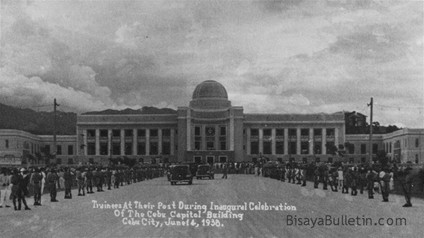Vintage photos of OLD CEBU can be found at BisayaBulletin.com.

🙂 😀 8)
I was resting in my Chicagoland home in early November 2007 (after my back-to-back trips to Washington DC and The Netherlands) when I received an e-mail from one of my STC classmates. Our US reunion had just been published at a new online magazine, BisayaBulletin.com. Thanks to a former childhood classmate from St. Theresa’s College in Cebu, Mike Mediano, he made sure we knew that the Bisaya-speaking community in the US has an online home they can call their “balay” or “ba’y.” The editors are Stella Antigua Peyton, May Toling Mediano, and Teresa Martinez Sepulveda. Yes, Tisay, it’s me — your old neighbor, Lorna.
May Mediano wrote about the reunion I hadn’t been able to attend — so I enjoyed looking at the photos and carefully read Marina Hamoy’s account of our reunion in Cebuano. Gee, my Cebuano is so-so because English has always been my first language. In high school, many of my classmates often poked fun at me, saying, “Ay, si Lorna, always spokening in dollars.”
That was many years ago.
During my UP Diliman years, I joined a varsitarian organization, the UP Panaghi-usa. Yes, I learned to speak Cebuano a little more fluently by joining a group from Cebu. I still cannot write a speech in Cebuano. I have absolutely no fear in public speaking but when someone asks me to speak “Bisaya,” I graciously decline. I don’t want to make a fool of myself among the Bisayan language pundits.
There were a lot of surprises in store for me as I clicked through the pages of Bisaya Bulletin’s archives. Since I left Cebu 22 years ago, I’ve been on a “time warp” regarding the faces of my friends from the Philippines. Yesterday, my sister, Noemi Dado, asked me if I remember Rep. Liza Largoza Maza as our dorm mate at the Sampaguita dormitory in UP Diliman. She had to show me a photo of the famous women’s rights advocate from an Inquirer.net article. “Ah yes, the one with the peaches and cream complexion. I remember that she had this very graceful walk. And that she had a very calm, quiet demeanor. But I really don’t remember her joining any of the mass actions in the mid-1970’s, but she was quite active in the dorm’s activities,” I finally recalled.
Back to BisayaBulletin.com.
To my delight, I saw group photos of my hometown’s friends and neighbors (and my classmates’ sisters) such as Joy Martinez Onozawa, Auau Figueroa Balce, and Ruth Paul Cruz. Among New Year’s Party photos, I was pleased to find Raymond Solano and his family. I could go on and on.
My assessment: BisayaBulletin.com is performing a needed service for homesick Bisayans like me. Personally, I’ve always had problems connecting with my Southern California Filipino American community because the population is spread far and wide among the counties. They have enclaves that don’t even know about each other. So, when I chat with old friends such as Dinah Bertulfo Katindig, Joey Solano, or Alden Salazar, I can rely on BisayaBulletin.com to trigger my sometimes-rusty memory of common friends who can be found in the pages of BisayaBulletin.com. Thank you to Claribel “Kuya” Ybanez for sending me a personal e-mail about the group’s editorial efforts.
I would also like everyone to note that there is an indigenous Philippine languages movement building an intellectual storm worldwide. If I may quote the yahoogroup, DILA, whose director, Manuel Faelnar, is someone I have been quietly following online for the past few years:
Welcome to one of the world’s most successful discussion forums in the internet. Here we compare words in our languages and learn other languages as a result.
This forum is the “home court” of DILA members based in the Philippines, the U.S., the U.K., Australia, Canada, Dubai and other countries.
DILA, which stands for Defenders of Indigenous Languages of the Archipelago, is a union among patriotic Pangasinenses, Pampanguenos, Bicolanos, Warays, Karay-as, Ilongos, Cebuanos, Ilocanos, and other ethno-linguistic groups in the Philippines who feel aggrieved by the language policy of their country, and whose passion in life centers around promoting their dear languages (and other aspects of their culture) and saving them from extinction. Their related activities include studying their languages and doing language translations, interpretations and comparisons in a scholarly way. They work for the intellectualization of their languages and aim to have them be made languages of instruction and regular subjects in the school curriculum. Love and pride for their languages motivated them into forging this grand alliance. All members of minority groups, as well as exceptionally sympathetic Tagalogs, are strongly encouraged to join us and participate in our intellectual discussions. We are here to destroy the growing Tagalista mentality that is marginalizing all native languages to no end. “United, we shall overcome!”
You can e-mail Manuel Faelnar at [email protected].
Leave a Reply